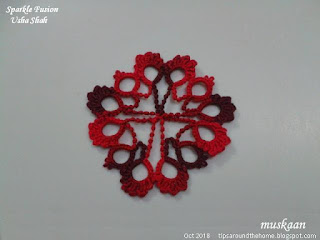It’s good to have friends in High
places – High in creativity and generosity!
I had been in a kind of tatting
funk for the past several days, despite the several ongoing projects. And then
my buddy Anita sent a pic of her hearts with counts inked and I was immediately
inspired into action!
Loaded my shuttles and went to work, with a couple of my
own patterns emerging. Couldn’t stop for 2-3 days! Towards the end I switched to 2
colours just to get a sense of the possible effect.
I keep forgetting to give the link
to Anita's multipurpose site – Lavender & Laces. Do check it out.
UPDATE (Feb 2019) : patterns shared here
UPDATE (Feb 2019) : patterns shared here
Inside Your
Heart
Anita Barry
The Anchor size 20 (in red) measures
3½ cms x 3 cms
I like how quick and simple this
is! My ring didn’t turn out a perfect circle as her's did. A slightly loose
tension while closing would help? It’s a bit better in the size 40 2-coloured
version where I used a self-closing mock ring.
♥♥♥♥♥
Cross My
Heart
Anita Barry
In Anchor Size 40, it measures 1”
x >1”
Worked with 2 shuttles using split
ring to climb out, and thrown/floating rings in outer round.
TIP: Start with the top ring of cross, to climb out with a split ring on the left.
Not happy with my first, I made a
few more with slight tweaks if you look carefully. Still not as pretty as
Anita’s, it does give the sense of soaring wings - it's an angel; it's a butterfly; no, it's a heart!
There was another folded ring heart which I didn't make. If interested, we can ask her to
share all her patterns.
♥♥♥♥♥
So are you wondering what happened
to that vintage butterfly from Corticelli?
It is still in same state
as I left it (I have something else in mind to finish it off), but the lower
wing florets have been purloined! I trapped them in my heart …
Budding
Heart #1
Worked in Anchor Size 40 & 20,
it measures 3½ cms x 4½ cms
The floral rings have longer
chains on the outside than the original, as I’d mentioned before.
TIP : Any pair, cluster or spray of florets can be used. Place it on a grid paper and draw the heart shape. Then join thread and tat the chain outline. Using the sketch as a constant guide.
Here’s the heart pattern :
Floral Rings -
For central ring : Make
8 long and 7 normal picots separated by 2ds. Close ring and climb out with a
mock picot.
Chains : 4 – 4 lock
join to smaller picot … all around (8 times).
Similarly make the 2nd
floral ring, joining to the first at any point in the outer chain.
For the heart outline, I switched
to Anchor size 20 (similar to Lizbeth 10).
Join continuous thread
to the picot of top floret, and work chain :
Chain: 3 CWJ 8 p 5 +
35. Join to 2nd floret, cut and tie and hide ends.
CWJ – Catherine Wheel Join gives a
smooth continuous outline.
♥♥♥♥♥
Budding
Heart #2
Months back, I had tried these Blossoms motifs in 2 strands of embroidery thread for my
MIL’s hanky corner, but didn’t use. After snipping off a 3rd floret
(forgot to take a pic), I placed it on the sketch, and hey, the same outline
worked!
Wondering how a butterfly would
look perched on the heart …
For the 2nd version, I
actually tatted a Blossoms butterfly linking the right and left halves through additional picots for lifted wings. The body ring was worked Under the wings and curled around the heart chain lengthwise. For further reinforcement, I tatted a smaller ring behind and repeated the attachment. Butterfly should've been worked with 2 strands, instead of 3 - seems a bit disproportionate now.
Future
Ideas
: Instead of butterfly, wrap some green tendrils with leaves around part of the
heart, emerging from the lower floret.
And pearl beads in the center of the
blossoms?
Interlocked rings for #1?
♥♥♥♥♥
Trailing
Hearts
I rarely go back to my old patterns, but just for the fun of it I tried this heart again. Could definitely
do with some improvement – it is a bit dense in the center! Perhaps a single
common join between the 3 rings? The pattern can be found here.
♥♥♥♥♥
And speaking of hearts the Tiny Heart Poppy – a 3D flower made from a 2D
heart - is back in this week’s popular list (see right panel)! Happens without
fail every year during the Remembrance Day period (and occasionally when some group swoops
down to tat it).
♥♥♥♥♥
keep tatting buddies close to your heart, always









































